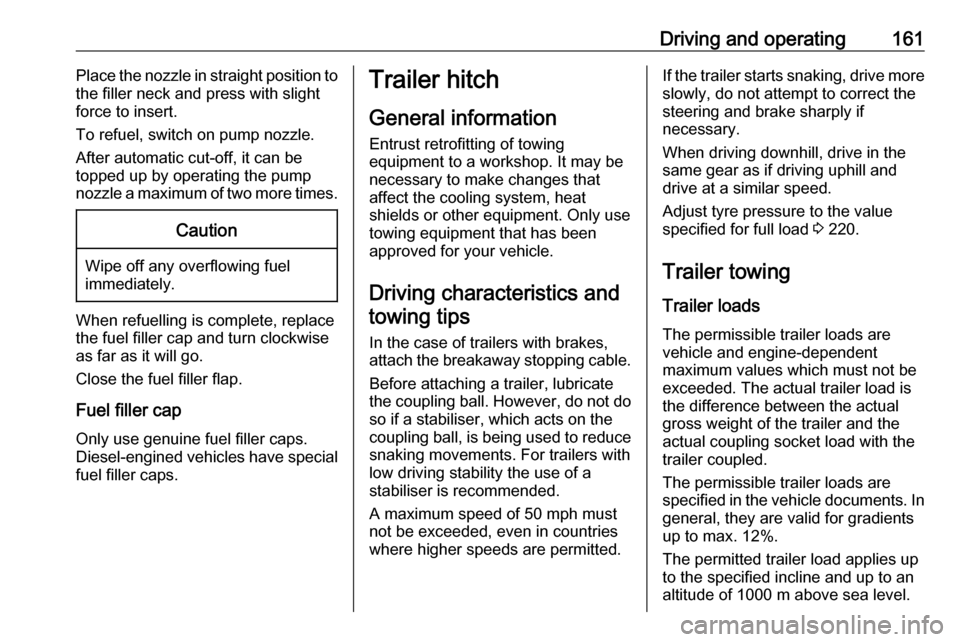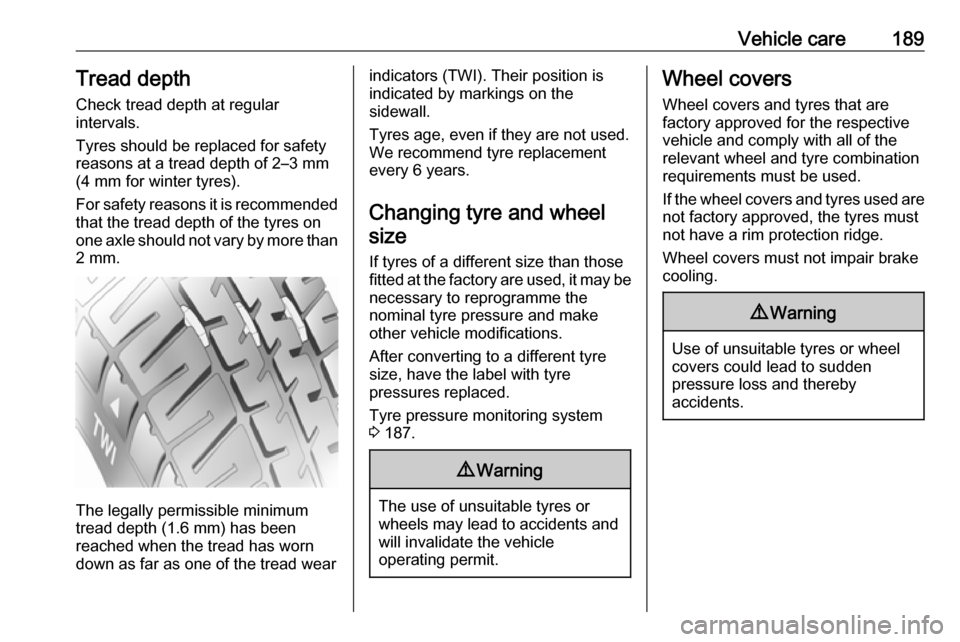cooling VAUXHALL VIVARO 2018.5 User Guide
[x] Cancel search | Manufacturer: VAUXHALL, Model Year: 2018.5, Model line: VIVARO, Model: VAUXHALL VIVARO 2018.5Pages: 239, PDF Size: 5.75 MB
Page 163 of 239

Driving and operating161Place the nozzle in straight position to
the filler neck and press with slight
force to insert.
To refuel, switch on pump nozzle.
After automatic cut-off, it can be
topped up by operating the pump
nozzle a maximum of two more times.Caution
Wipe off any overflowing fuel
immediately.
When refuelling is complete, replace
the fuel filler cap and turn clockwise
as far as it will go.
Close the fuel filler flap.
Fuel filler cap Only use genuine fuel filler caps.Diesel-engined vehicles have special
fuel filler caps.
Trailer hitch
General information
Entrust retrofitting of towing
equipment to a workshop. It may be
necessary to make changes that
affect the cooling system, heat
shields or other equipment. Only use
towing equipment that has been
approved for your vehicle.
Driving characteristics and towing tips
In the case of trailers with brakes,
attach the breakaway stopping cable.
Before attaching a trailer, lubricate
the coupling ball. However, do not do
so if a stabiliser, which acts on the
coupling ball, is being used to reduce
snaking movements. For trailers with
low driving stability the use of a
stabiliser is recommended.
A maximum speed of 50 mph must
not be exceeded, even in countries
where higher speeds are permitted.If the trailer starts snaking, drive more slowly, do not attempt to correct the
steering and brake sharply if
necessary.
When driving downhill, drive in the
same gear as if driving uphill and
drive at a similar speed.
Adjust tyre pressure to the value
specified for full load 3 220.
Trailer towing
Trailer loads The permissible trailer loads are
vehicle and engine-dependent
maximum values which must not be
exceeded. The actual trailer load is the difference between the actual
gross weight of the trailer and the
actual coupling socket load with the
trailer coupled.
The permissible trailer loads are
specified in the vehicle documents. In
general, they are valid for gradients
up to max. 12%.
The permitted trailer load applies up
to the specified incline and up to an
altitude of 1000 m above sea level.
Page 167 of 239

Vehicle care165End-of-life vehicle recovery
Information on end-of-life vehicle
recovery centres and the recycling of
end-of-life vehicles is available on our website, where legally required. Only
entrust this work to an authorised
recycling centre.Vehicle checks
Performing work9 Warning
Only perform engine compartment
checks when the ignition is off.
The vehicle must not be in an
Autostop 3 135.
The cooling fan may start
operating even if the ignition is off.
9 Danger
The ignition system generates
extremely high voltages. Do not
touch.
The caps for topping up the engine oil, the coolant, the brake fluid, the
washer fluid and the oil dipstick
handle are yellow for ease of
identification.
Bonnet
Opening
Pull the release lever and return it to
its original position.
Page 170 of 239

168Vehicle careIf the red tell-tale is displayed when
the engine is running, consult a
workshop.
Engine coolant The coolant provides freeze
protection down to approx. -28 °C.Caution
Only use approved antifreeze.
Coolant level
Caution
Too low a coolant level can cause engine damage.
If the cooling system is cold, the
coolant level should be just above the
MINI mark. Top-up if the level is low.
9Warning
Allow the engine to cool before
opening the cap. Carefully open
the cap, relieving the pressure
slowly.
Top-up with antifreeze. If no
antifreeze is available, use clean tap
water or distilled water. Install the cap
tightly. Have the antifreeze
concentration checked and have the
cause of the coolant loss remedied by a workshop.
If a substantial amount of coolant is
required, it will be necessary to bleed
any trapped air from the cooling
system. Seek the assistance of a
workshop.
If the coolant temperature is too high, control indicator W 3 98 illuminates
red in the instrument cluster, together
with C 3 97. Consult a workshop if
coolant level is sufficient.
Power steering fluidCaution
Extremely small amounts of
contamination can cause steering
system damage and cause it to not work properly. Do not allow
contaminates to contact the fluid
side of the reservoir cap or from
entering the reservoir.
The power steering fluid reservoir is located below the front left wheel
arch, behind a trim panel.
Page 191 of 239

Vehicle care189Tread depthCheck tread depth at regular
intervals.
Tyres should be replaced for safety
reasons at a tread depth of 2–3 mm
(4 mm for winter tyres).
For safety reasons it is recommended
that the tread depth of the tyres on
one axle should not vary by more than
2 mm.
The legally permissible minimum
tread depth (1.6 mm) has been
reached when the tread has worn
down as far as one of the tread wear
indicators (TWI). Their position is
indicated by markings on the
sidewall.
Tyres age, even if they are not used.
We recommend tyre replacement
every 6 years.
Changing tyre and wheel size
If tyres of a different size than those fitted at the factory are used, it may be necessary to reprogramme the
nominal tyre pressure and make
other vehicle modifications.
After converting to a different tyre
size, have the label with tyre
pressures replaced.
Tyre pressure monitoring system
3 187.9 Warning
The use of unsuitable tyres or
wheels may lead to accidents and will invalidate the vehicle
operating permit.
Wheel covers
Wheel covers and tyres that are
factory approved for the respective
vehicle and comply with all of the
relevant wheel and tyre combination
requirements must be used.
If the wheel covers and tyres used are
not factory approved, the tyres must
not have a rim protection ridge.
Wheel covers must not impair brake
cooling.9 Warning
Use of unsuitable tyres or wheel
covers could lead to sudden
pressure loss and thereby
accidents.
Page 233 of 239

231Child locks ................................... 30
Child restraint installation locations ................................... 66
Child restraints.............................. 64
Child restraint systems ................64
Cigarette lighter ........................... 88
Cleaning the vehicle ...................199
Climate control ............................. 15
Climate control systems .............116
Clock ............................................ 86
Coat hooks ................................... 73
Coin holder ................................... 71
Control indicators.......................... 92
Control of the vehicle .................130
Controls ........................................ 83
Controls in steering wheel ............83
Convex shape .............................. 39
Coolant ....................................... 168
Coolant and antifreeze ...............204
Coolant heater ............................ 122
Cooling (A/C) .............................. 117
Cornering lights .......................... 110
Cruise control ....................101, 151
Cupholders .................................. 73
Curtain airbag system .................. 62
D Danger, Warnings and Cautions ...4
Dashboard .................................... 10
Daytime running lights ........109, 110Declaration of conformity ............221
DEF ............................................ 140
Demisting and defrosting ..............15
Diesel exhaust fluid ....................140
Diesel fuel ................................... 159
Diesel fuel filter .......................... 172
Diesel fuel system bleeding .......172
Diesel particle filter ....................139
Directional tyres ..................185, 195
Distance to service .......................92
Document tray .............................. 73
Door locks..................................... 24
Door open .................................. 101
Door panel storage .......................74
Doors ............................................ 31
Double cab ................................... 74
DPF (diesel particle filter) ...........139
Driver assistance systems ..........151
Driver Information Centre ...........101
Driving characteristics and towing tips .............................. 161
Driving economically................... 129
Driving hints ........................ 129, 130
Driving style indicator ...................91
E
ECO mode .................................. 129
ecoScoring.................................. 104
Electric adjustment ......................39
Electrical accessories ...................87Electrical system......................... 180
Electronic climate control system 118
Electronic data recording ..............41
Electronic key system ...................21
Electronic Stability Program 98,
149, 162
Electronic Stability Program off ...98
End-of-life vehicle recovery .......165
Engine air filter............................ 167
Engine air flow indicator .............167
Engine coolant ........................... 168
Engine coolant temperature ........98
Engine data ............................... 209
Engine Drag Torque Control ......149
Engine exhaust .......................... 139
Engine identification ...................207
Engine oil ................... 166, 204, 208
Engine oil additives ....................204
Engine oil level .......................... 104
Engine oil pressure ......................99
Engine oil viscosity grades .........204
Enhanced Traction function 148, 149
Entry lighting .............................. 114
Event data recorders ..................225
Exhaust gases ....................139, 198
Exit lighting ................................ 114
Exterior care .............................. 199
Exterior light ............................... 100
Exterior lighting ....................12, 108
Exterior mirrors ............................. 39